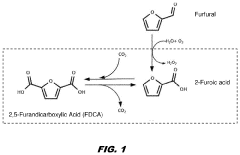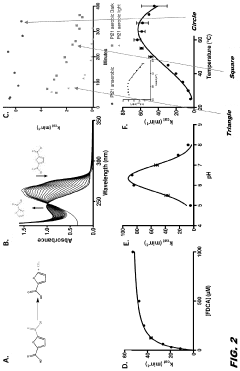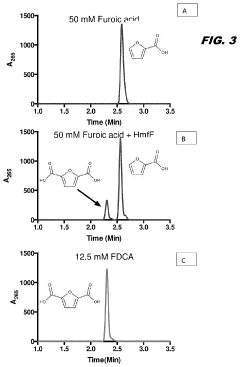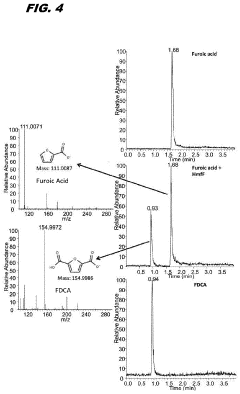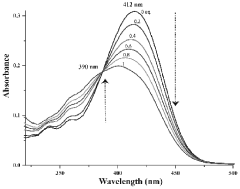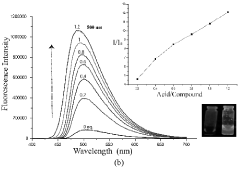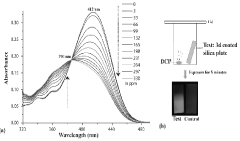Fluoroantimonic Acid in Shaping the Future of Chemistry
JUN 20, 20259 MIN READ
Generate Your Research Report Instantly with AI Agent
Patsnap Eureka helps you evaluate technical feasibility & market potential.
Fluoroantimonic Acid Background and Objectives
Fluoroantimonic acid, often referred to as the world's strongest superacid, has been a subject of intense scientific interest since its discovery in the 1960s. This compound, with its unprecedented acidity, has revolutionized our understanding of acid-base chemistry and opened new avenues for chemical reactions previously thought impossible.
The development of fluoroantimonic acid can be traced back to the pioneering work of George A. Olah, who later won the Nobel Prize in Chemistry for his contributions to carbocation chemistry. Olah's research on superacids laid the groundwork for the synthesis and characterization of fluoroantimonic acid, a mixture of hydrogen fluoride (HF) and antimony pentafluoride (SbF5).
As research progressed, the unique properties of fluoroantimonic acid became increasingly apparent. Its ability to protonate even extremely weak bases and generate highly reactive carbocations has made it an invaluable tool in organic synthesis and petrochemical processes. The acid's extreme corrosiveness and reactivity have also posed significant challenges in handling and application, driving innovations in materials science and containment technologies.
The evolution of fluoroantimonic acid research has been marked by continuous efforts to understand its structure, behavior, and potential applications. Recent advancements in spectroscopic techniques and computational chemistry have provided deeper insights into the acid's molecular dynamics and reaction mechanisms.
Looking ahead, the objectives for fluoroantimonic acid research are multifaceted. One primary goal is to expand its applications in organic synthesis, particularly in the creation of novel pharmaceutical compounds and advanced materials. Researchers aim to harness its unparalleled acidity to catalyze reactions that are otherwise energetically unfavorable or kinetically slow.
Another critical objective is to develop safer and more efficient methods for handling and utilizing fluoroantimonic acid. This includes the design of new containment materials and the exploration of supported acid systems that could mitigate some of the risks associated with its use while maintaining its exceptional reactivity.
Furthermore, there is growing interest in understanding the fundamental nature of superacidity and its limits. Scientists are investigating whether even stronger superacids can be synthesized and what implications this might have for our understanding of acid-base chemistry and chemical reactivity in extreme environments.
As we look to the future, fluoroantimonic acid stands at the forefront of chemical innovation, promising to shape the landscape of synthetic chemistry, materials science, and beyond. The ongoing research in this field not only pushes the boundaries of what is chemically possible but also challenges us to rethink our approaches to handling and utilizing highly reactive substances in both laboratory and industrial settings.
The development of fluoroantimonic acid can be traced back to the pioneering work of George A. Olah, who later won the Nobel Prize in Chemistry for his contributions to carbocation chemistry. Olah's research on superacids laid the groundwork for the synthesis and characterization of fluoroantimonic acid, a mixture of hydrogen fluoride (HF) and antimony pentafluoride (SbF5).
As research progressed, the unique properties of fluoroantimonic acid became increasingly apparent. Its ability to protonate even extremely weak bases and generate highly reactive carbocations has made it an invaluable tool in organic synthesis and petrochemical processes. The acid's extreme corrosiveness and reactivity have also posed significant challenges in handling and application, driving innovations in materials science and containment technologies.
The evolution of fluoroantimonic acid research has been marked by continuous efforts to understand its structure, behavior, and potential applications. Recent advancements in spectroscopic techniques and computational chemistry have provided deeper insights into the acid's molecular dynamics and reaction mechanisms.
Looking ahead, the objectives for fluoroantimonic acid research are multifaceted. One primary goal is to expand its applications in organic synthesis, particularly in the creation of novel pharmaceutical compounds and advanced materials. Researchers aim to harness its unparalleled acidity to catalyze reactions that are otherwise energetically unfavorable or kinetically slow.
Another critical objective is to develop safer and more efficient methods for handling and utilizing fluoroantimonic acid. This includes the design of new containment materials and the exploration of supported acid systems that could mitigate some of the risks associated with its use while maintaining its exceptional reactivity.
Furthermore, there is growing interest in understanding the fundamental nature of superacidity and its limits. Scientists are investigating whether even stronger superacids can be synthesized and what implications this might have for our understanding of acid-base chemistry and chemical reactivity in extreme environments.
As we look to the future, fluoroantimonic acid stands at the forefront of chemical innovation, promising to shape the landscape of synthetic chemistry, materials science, and beyond. The ongoing research in this field not only pushes the boundaries of what is chemically possible but also challenges us to rethink our approaches to handling and utilizing highly reactive substances in both laboratory and industrial settings.
Market Analysis for Superacid Applications
The market for superacid applications, particularly those involving fluoroantimonic acid, has shown significant growth potential in recent years. This powerful superacid, known for its extreme acidity and unique chemical properties, has found increasing use across various industrial sectors. The petrochemical industry remains the largest consumer of fluoroantimonic acid, utilizing it in catalytic cracking processes and isomerization reactions. The demand in this sector is driven by the ongoing need for more efficient fuel production and the development of high-performance lubricants.
In the electronics industry, fluoroantimonic acid has gained traction for its role in etching and cleaning processes for semiconductor manufacturing. As the demand for smaller, more powerful electronic devices continues to rise, the market for specialized chemicals like fluoroantimonic acid is expected to expand. The growing emphasis on miniaturization and increased performance in electronics is likely to sustain this trend in the foreseeable future.
The pharmaceutical sector represents another promising market for fluoroantimonic acid applications. Its use in the synthesis of complex organic compounds and as a catalyst in drug manufacturing processes has attracted attention from pharmaceutical companies seeking to optimize their production methods. The increasing focus on developing novel drug molecules and improving existing formulations is expected to drive demand in this sector.
Emerging applications in materials science, particularly in the development of advanced polymers and composite materials, are opening new avenues for fluoroantimonic acid usage. Research into super-strong materials and innovative surface treatments has highlighted the potential of this superacid in creating materials with enhanced properties, which could lead to breakthroughs in aerospace, automotive, and construction industries.
However, the market for fluoroantimonic acid faces challenges related to its extreme corrosiveness and the need for specialized handling and storage. These factors limit its widespread adoption and necessitate significant investments in safety measures and equipment. Additionally, environmental concerns and stringent regulations regarding the use and disposal of such powerful acids may impact market growth in certain regions.
Despite these challenges, the global market for fluoroantimonic acid and related superacid applications is projected to grow steadily. This growth is underpinned by ongoing research into new applications, improvements in handling technologies, and the continuous drive for innovation in chemical processes across industries. As industries seek more efficient and effective chemical solutions, the unique properties of fluoroantimonic acid position it as a key player in shaping the future of chemistry and industrial processes.
In the electronics industry, fluoroantimonic acid has gained traction for its role in etching and cleaning processes for semiconductor manufacturing. As the demand for smaller, more powerful electronic devices continues to rise, the market for specialized chemicals like fluoroantimonic acid is expected to expand. The growing emphasis on miniaturization and increased performance in electronics is likely to sustain this trend in the foreseeable future.
The pharmaceutical sector represents another promising market for fluoroantimonic acid applications. Its use in the synthesis of complex organic compounds and as a catalyst in drug manufacturing processes has attracted attention from pharmaceutical companies seeking to optimize their production methods. The increasing focus on developing novel drug molecules and improving existing formulations is expected to drive demand in this sector.
Emerging applications in materials science, particularly in the development of advanced polymers and composite materials, are opening new avenues for fluoroantimonic acid usage. Research into super-strong materials and innovative surface treatments has highlighted the potential of this superacid in creating materials with enhanced properties, which could lead to breakthroughs in aerospace, automotive, and construction industries.
However, the market for fluoroantimonic acid faces challenges related to its extreme corrosiveness and the need for specialized handling and storage. These factors limit its widespread adoption and necessitate significant investments in safety measures and equipment. Additionally, environmental concerns and stringent regulations regarding the use and disposal of such powerful acids may impact market growth in certain regions.
Despite these challenges, the global market for fluoroantimonic acid and related superacid applications is projected to grow steadily. This growth is underpinned by ongoing research into new applications, improvements in handling technologies, and the continuous drive for innovation in chemical processes across industries. As industries seek more efficient and effective chemical solutions, the unique properties of fluoroantimonic acid position it as a key player in shaping the future of chemistry and industrial processes.
Current Challenges in Fluoroantimonic Acid Research
Fluoroantimonic acid, known as the world's strongest superacid, presents several significant challenges in current research and application. One of the primary obstacles is its extreme reactivity, which makes handling and storage exceptionally difficult. The acid's corrosive nature necessitates specialized containment materials, typically fluoropolymers like Teflon, as it reacts violently with most conventional laboratory equipment.
The synthesis and purification of fluoroantimonic acid pose considerable challenges. The process requires precise control of reaction conditions and sophisticated equipment to prevent contamination and ensure purity. Researchers struggle to maintain consistent quality across batches, which can affect experimental reproducibility and potential industrial applications.
Safety concerns represent another major hurdle in fluoroantimonic acid research. Its ability to protonate even weak bases and its extreme corrosiveness make it hazardous to work with, requiring stringent safety protocols and specialized training for researchers. This limits the number of facilities capable of conducting experiments with the acid, potentially slowing down research progress.
The environmental impact of fluoroantimonic acid is a growing concern. Its production and use generate hazardous waste that requires careful disposal. Developing eco-friendly synthesis methods and finding ways to recycle or neutralize the acid after use are ongoing challenges that researchers must address to make its application more sustainable.
Scaling up production for industrial use presents significant engineering challenges. The acid's reactivity and the need for specialized equipment make large-scale manufacturing processes complex and expensive. Researchers are working on innovative reactor designs and process controls to overcome these limitations.
Understanding the full scope of fluoroantimonic acid's potential applications remains an ongoing challenge. While its superacidity offers unique catalytic properties, researchers are still exploring novel reactions and processes where it could provide significant advantages over conventional acids. This requires extensive experimentation and collaboration across various chemistry subdisciplines.
The characterization of fluoroantimonic acid and its reactions at the molecular level is another area of active research. Advanced spectroscopic techniques and computational modeling are being employed to elucidate its structure and behavior in different environments. However, the extreme nature of the acid often pushes the limits of current analytical methods, necessitating the development of new characterization tools.
The synthesis and purification of fluoroantimonic acid pose considerable challenges. The process requires precise control of reaction conditions and sophisticated equipment to prevent contamination and ensure purity. Researchers struggle to maintain consistent quality across batches, which can affect experimental reproducibility and potential industrial applications.
Safety concerns represent another major hurdle in fluoroantimonic acid research. Its ability to protonate even weak bases and its extreme corrosiveness make it hazardous to work with, requiring stringent safety protocols and specialized training for researchers. This limits the number of facilities capable of conducting experiments with the acid, potentially slowing down research progress.
The environmental impact of fluoroantimonic acid is a growing concern. Its production and use generate hazardous waste that requires careful disposal. Developing eco-friendly synthesis methods and finding ways to recycle or neutralize the acid after use are ongoing challenges that researchers must address to make its application more sustainable.
Scaling up production for industrial use presents significant engineering challenges. The acid's reactivity and the need for specialized equipment make large-scale manufacturing processes complex and expensive. Researchers are working on innovative reactor designs and process controls to overcome these limitations.
Understanding the full scope of fluoroantimonic acid's potential applications remains an ongoing challenge. While its superacidity offers unique catalytic properties, researchers are still exploring novel reactions and processes where it could provide significant advantages over conventional acids. This requires extensive experimentation and collaboration across various chemistry subdisciplines.
The characterization of fluoroantimonic acid and its reactions at the molecular level is another area of active research. Advanced spectroscopic techniques and computational modeling are being employed to elucidate its structure and behavior in different environments. However, the extreme nature of the acid often pushes the limits of current analytical methods, necessitating the development of new characterization tools.
Existing Applications of Fluoroantimonic Acid
01 Synthesis and production of fluoroantimonic acid
Fluoroantimonic acid is synthesized through the reaction of hydrogen fluoride and antimony pentafluoride. The production process involves careful handling of highly reactive and corrosive materials under controlled conditions. Various methods and apparatus have been developed to optimize the synthesis and ensure the purity of the final product.- Synthesis and production of fluoroantimonic acid: Fluoroantimonic acid is synthesized through the reaction of hydrogen fluoride and antimony pentafluoride. The production process involves careful handling of highly reactive and corrosive materials under controlled conditions. Various methods and apparatus have been developed to optimize the synthesis and ensure the purity of the final product.
- Applications in chemical reactions and catalysis: Fluoroantimonic acid is utilized as a powerful superacid catalyst in various chemical reactions. It is particularly effective in promoting alkylation, isomerization, and polymerization processes. The acid's extreme acidity enables it to catalyze reactions that are difficult or impossible with conventional acids, making it valuable in organic synthesis and petrochemical industries.
- Material compatibility and storage: Due to its highly corrosive nature, fluoroantimonic acid requires specialized materials for handling and storage. Research has been conducted on developing compatible materials, such as fluoropolymers and certain alloys, that can withstand the acid's corrosive properties. Proper storage and containment systems are crucial to prevent leaks and ensure safety in industrial settings.
- Safety measures and environmental considerations: Handling fluoroantimonic acid requires strict safety protocols due to its extreme reactivity and corrosiveness. Research has focused on developing improved safety measures, including personal protective equipment, containment systems, and emergency response procedures. Additionally, studies have been conducted on the environmental impact of fluoroantimonic acid and methods for its safe disposal or neutralization.
- Analytical applications and detection methods: Fluoroantimonic acid has found use in analytical chemistry for its unique properties. Research has been conducted on developing methods for detecting and quantifying fluoroantimonic acid in various matrices. These analytical techniques are important for quality control in production processes and for environmental monitoring purposes.
02 Applications in organic synthesis and catalysis
Fluoroantimonic acid is utilized as a powerful superacid catalyst in various organic synthesis reactions. It facilitates processes such as alkylation, isomerization, and polymerization of hydrocarbons. The acid's extreme acidity enables it to catalyze reactions that are challenging or impossible with conventional acids.Expand Specific Solutions03 Use in materials science and surface treatment
Fluoroantimonic acid finds applications in materials science, particularly in surface treatment and modification of various substrates. It can be used to etch or activate surfaces, create specialized coatings, or modify the properties of materials such as polymers and ceramics.Expand Specific Solutions04 Safety and handling considerations
Due to its extreme corrosiveness and reactivity, special safety measures and handling procedures are required when working with fluoroantimonic acid. This includes the use of specialized containment materials, personal protective equipment, and strict protocols for storage, transport, and disposal to prevent accidents and environmental contamination.Expand Specific Solutions05 Analytical and characterization methods
Various analytical techniques and characterization methods have been developed to study fluoroantimonic acid and its reactions. These include spectroscopic methods, electrochemical analysis, and specialized equipment designed to handle and measure the properties of this highly reactive superacid under controlled conditions.Expand Specific Solutions
Key Players in Fluoroantimonic Acid Development
The field of Fluoroantimonic Acid in chemistry is in a nascent stage of development, characterized by intensive research and emerging applications. The market size is relatively small but growing, driven by its potential in catalysis and materials science. Technologically, it's still in the early maturity phase, with ongoing research to fully understand and harness its properties. Key players like DuPont de Nemours, Inc., Merck Sharp & Dohme Corp., and 3M Innovative Properties Co. are at the forefront, investing in R&D to explore its applications. Universities such as Hunan University and Beijing Normal University are contributing to fundamental research, while companies like Bayer AG and Shell Oil Co. are investigating industrial applications. The competitive landscape is dynamic, with both academic institutions and industry leaders vying to unlock the full potential of this powerful superacid.
DuPont de Nemours, Inc.
Technical Solution: DuPont has developed a proprietary process for the synthesis and handling of fluoroantimonic acid, utilizing specialized containment systems and advanced materials resistant to its extreme corrosiveness. Their method involves the controlled reaction of hydrogen fluoride with antimony pentafluoride under precisely regulated conditions. DuPont's approach also includes innovative purification techniques to achieve ultra-high purity levels, crucial for advanced applications in organic synthesis and materials science.
Strengths: Extensive experience in handling highly reactive chemicals, advanced containment technologies. Weaknesses: High production costs, limited scalability due to safety concerns.
Bayer AG
Technical Solution: Bayer has developed a novel application of fluoroantimonic acid in the synthesis of advanced pharmaceutical intermediates. Their approach involves using the superacid as a catalyst in stereoselective reactions, enabling the creation of complex molecular structures with high efficiency. Bayer's method incorporates a unique neutralization and waste management system to address the environmental concerns associated with fluoroantimonic acid use. They have also pioneered safety protocols for large-scale handling of this superacid in pharmaceutical manufacturing settings.
Strengths: Innovative application in pharmaceutical synthesis, robust safety protocols. Weaknesses: High regulatory hurdles, potential environmental concerns.
Breakthrough Innovations in Superacid Technology
Methods of producing 2,5-furandicarboxylic acid
PatentInactiveUS20210180095A1
Innovation
- An enzymatic method involving a HmfF polypeptide with specific amino acid sequences, such as those from Pelotomaculum thermopropionicum and Geobacillus kaustophilus, is used to convert furoic acid into FDCA in the presence of carbon dioxide, utilizing a reactor under pressure to enhance the reaction.
Novel heterocyclic probe, preparation method and application thereof
PatentActiveIN201611029461A
Innovation
- Development of a novel benzophenone-quinoline probe that exhibits significant changes in absorption and emission bands under acidic conditions, enabling rapid and reversible detection of acid vapors and chemical warfare agents, integrated into a sensor device with a circuit comprising light emitting diodes, resistors, and a relay for alarm activation.
Safety and Environmental Considerations
Fluoroantimonic acid, known as the world's strongest superacid, presents significant safety and environmental challenges that must be carefully addressed in its production, handling, and disposal. The extreme corrosiveness and reactivity of this compound necessitate stringent safety protocols and specialized containment systems to protect workers and prevent environmental contamination.
In laboratory and industrial settings, the use of fluoroantimonic acid requires advanced personal protective equipment (PPE), including fully encapsulating chemical-resistant suits, self-contained breathing apparatus, and multiple layers of chemical-resistant gloves. Handling procedures must be conducted in rigorously controlled environments, such as inert atmosphere gloveboxes, to prevent exposure to moisture or organic materials that could lead to violent reactions.
The storage and transport of fluoroantimonic acid pose additional safety concerns. Specialized containers made of materials resistant to superacids, such as polytetrafluoroethylene (PTFE) or certain fluoropolymers, are essential to prevent leaks and maintain the integrity of the acid. These containers must be regularly inspected and replaced to ensure ongoing safety.
Environmental considerations for fluoroantimonic acid are equally critical. Accidental release into the environment could have catastrophic consequences, potentially causing severe damage to ecosystems and posing long-term risks to human health. Proper disposal methods are crucial and typically involve neutralization processes followed by specialized waste treatment procedures.
The production of fluoroantimonic acid also raises environmental concerns due to the energy-intensive processes and the use of hazardous precursor materials. Efforts to develop more sustainable production methods and to minimize waste generation are ongoing areas of research in the chemical industry.
Regulatory frameworks governing the use of fluoroantimonic acid vary globally, but generally include strict guidelines for its manufacture, storage, transport, and disposal. Compliance with these regulations is essential for companies working with this superacid, and often requires significant investment in safety infrastructure and training programs.
As research into applications of fluoroantimonic acid continues, there is a growing focus on developing safer alternatives or modified versions that retain its useful properties while mitigating safety and environmental risks. This includes exploring encapsulation techniques, developing more stable formulations, and investigating catalytic systems that can achieve similar results with reduced hazards.
In laboratory and industrial settings, the use of fluoroantimonic acid requires advanced personal protective equipment (PPE), including fully encapsulating chemical-resistant suits, self-contained breathing apparatus, and multiple layers of chemical-resistant gloves. Handling procedures must be conducted in rigorously controlled environments, such as inert atmosphere gloveboxes, to prevent exposure to moisture or organic materials that could lead to violent reactions.
The storage and transport of fluoroantimonic acid pose additional safety concerns. Specialized containers made of materials resistant to superacids, such as polytetrafluoroethylene (PTFE) or certain fluoropolymers, are essential to prevent leaks and maintain the integrity of the acid. These containers must be regularly inspected and replaced to ensure ongoing safety.
Environmental considerations for fluoroantimonic acid are equally critical. Accidental release into the environment could have catastrophic consequences, potentially causing severe damage to ecosystems and posing long-term risks to human health. Proper disposal methods are crucial and typically involve neutralization processes followed by specialized waste treatment procedures.
The production of fluoroantimonic acid also raises environmental concerns due to the energy-intensive processes and the use of hazardous precursor materials. Efforts to develop more sustainable production methods and to minimize waste generation are ongoing areas of research in the chemical industry.
Regulatory frameworks governing the use of fluoroantimonic acid vary globally, but generally include strict guidelines for its manufacture, storage, transport, and disposal. Compliance with these regulations is essential for companies working with this superacid, and often requires significant investment in safety infrastructure and training programs.
As research into applications of fluoroantimonic acid continues, there is a growing focus on developing safer alternatives or modified versions that retain its useful properties while mitigating safety and environmental risks. This includes exploring encapsulation techniques, developing more stable formulations, and investigating catalytic systems that can achieve similar results with reduced hazards.
Potential Industrial Impact of Fluoroantimonic Acid
Fluoroantimonic acid, known as the world's strongest superacid, has the potential to revolutionize various industrial sectors. Its exceptional protonating ability and extreme acidity open up new possibilities for chemical processes and material synthesis.
In the petrochemical industry, fluoroantimonic acid could significantly enhance the efficiency of catalytic cracking and isomerization processes. Its superior acidity may enable the conversion of lower-value hydrocarbons into higher-value products at lower temperatures and pressures, potentially reducing energy consumption and operational costs. This could lead to more economical production of gasoline, diesel, and other petroleum-based products.
The semiconductor industry may benefit from fluoroantimonic acid's ability to etch and clean surfaces at the nanoscale. Its extreme reactivity could facilitate the production of smaller, more efficient microchips and electronic components. This could contribute to advancements in computing power, miniaturization of devices, and the development of next-generation electronics.
In materials science, fluoroantimonic acid's unique properties could enable the synthesis of novel materials with enhanced properties. It may facilitate the creation of super-strong polymers, advanced ceramics, or new classes of composite materials. These innovations could find applications in aerospace, automotive, and construction industries, leading to lighter, stronger, and more durable products.
The pharmaceutical industry might leverage fluoroantimonic acid for the synthesis of complex organic compounds. Its powerful protonating ability could enable new reaction pathways, potentially leading to more efficient drug synthesis processes or the development of novel therapeutic compounds. This could accelerate drug discovery and reduce production costs in pharmaceutical manufacturing.
In the field of energy storage, fluoroantimonic acid could play a role in developing advanced battery technologies. Its extreme acidity might enable the creation of new electrolytes or electrode materials with improved performance characteristics, potentially leading to batteries with higher energy density, faster charging capabilities, and longer lifespans.
However, the industrial adoption of fluoroantimonic acid faces significant challenges. Its extreme corrosiveness and reactivity require specialized handling and containment systems, which may limit its widespread use. Safety concerns and environmental considerations also need to be carefully addressed before large-scale industrial applications can be realized.
Despite these challenges, the potential industrial impact of fluoroantimonic acid is substantial. Its unique properties could drive innovation across multiple sectors, leading to more efficient processes, novel materials, and groundbreaking products. As research progresses and handling techniques improve, fluoroantimonic acid may become a transformative tool in shaping the future of industrial chemistry and materials science.
In the petrochemical industry, fluoroantimonic acid could significantly enhance the efficiency of catalytic cracking and isomerization processes. Its superior acidity may enable the conversion of lower-value hydrocarbons into higher-value products at lower temperatures and pressures, potentially reducing energy consumption and operational costs. This could lead to more economical production of gasoline, diesel, and other petroleum-based products.
The semiconductor industry may benefit from fluoroantimonic acid's ability to etch and clean surfaces at the nanoscale. Its extreme reactivity could facilitate the production of smaller, more efficient microchips and electronic components. This could contribute to advancements in computing power, miniaturization of devices, and the development of next-generation electronics.
In materials science, fluoroantimonic acid's unique properties could enable the synthesis of novel materials with enhanced properties. It may facilitate the creation of super-strong polymers, advanced ceramics, or new classes of composite materials. These innovations could find applications in aerospace, automotive, and construction industries, leading to lighter, stronger, and more durable products.
The pharmaceutical industry might leverage fluoroantimonic acid for the synthesis of complex organic compounds. Its powerful protonating ability could enable new reaction pathways, potentially leading to more efficient drug synthesis processes or the development of novel therapeutic compounds. This could accelerate drug discovery and reduce production costs in pharmaceutical manufacturing.
In the field of energy storage, fluoroantimonic acid could play a role in developing advanced battery technologies. Its extreme acidity might enable the creation of new electrolytes or electrode materials with improved performance characteristics, potentially leading to batteries with higher energy density, faster charging capabilities, and longer lifespans.
However, the industrial adoption of fluoroantimonic acid faces significant challenges. Its extreme corrosiveness and reactivity require specialized handling and containment systems, which may limit its widespread use. Safety concerns and environmental considerations also need to be carefully addressed before large-scale industrial applications can be realized.
Despite these challenges, the potential industrial impact of fluoroantimonic acid is substantial. Its unique properties could drive innovation across multiple sectors, leading to more efficient processes, novel materials, and groundbreaking products. As research progresses and handling techniques improve, fluoroantimonic acid may become a transformative tool in shaping the future of industrial chemistry and materials science.
Unlock deeper insights with Patsnap Eureka Quick Research — get a full tech report to explore trends and direct your research. Try now!
Generate Your Research Report Instantly with AI Agent
Supercharge your innovation with Patsnap Eureka AI Agent Platform!
